Machinery generally consists of a chassis (e.g. housing, frame, base) plus mobile machine components and electronic modules.
Machinery contains no water (WCC 0). Packaging may consist of box lumber or paperboard and has a water content of < 30% (nbsp WCC 2). This relatively high water content is problematic for much machinery and equipment due to its sensitivity to corrosion. Since corrosion may begin at a relative humidity of as low as > 40%, most machinery and equipment must be protected from this humidity/moisture by various corrosion protection measures and methods (humidity/moisture and possibly ventilation conditions SC IV). While ventilation may reduce the risk of corrosion, it is not in itself an effective method of providing corrosion protection. For this reason, all goods which are at risk of corrosion must be specially protected. Such goods should be transported in standard containers, subject to compliance with limits for water content of packaging and container floor.
Transport instructions and damage
Packaging
Machinery is usually transported in cases or crates of a size appropriate for the machine's dimensions. Cases are mainly made from softwood (e.g. spruce, pine, poplar) in accordance with recognized guidelines (e.g. HPE standards).
Machinery is often attached to pallets, while associated components are packaged in cartons and likewise attached to the pallet (see Fig. 192).
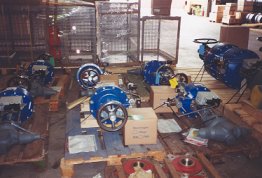 |
| Figure 192: Machinery attached to pallets, components packaged in cartons likewise attached to the pallet. |
To provide protection from corrosion, machinery is enclosed in plastic film which is impermeable to water vapor (see Figs. 193, 194). Care must be taken to ensure that the film remains completely undamaged. Sharp corners must be carefully padded as the film package must be absolutely impermeable to water vapor. Particular care must be taken at any points where the film must be punctured, e.g. where the machinery is bolted to the case bottom. A rubber seal must be provided on both sides anywhere where the film has to be punctured, e.g. around a bolt to the case bottom. The film enclosure isolates the packaged equipment from the ambient air, so making it possible to exercise long-term control over the "microclimate" inside the package. A calculated quantity of desiccants ensures that relative humidity cannot rise above 40%, so stopping corrosion in its tracks (desiccant method).
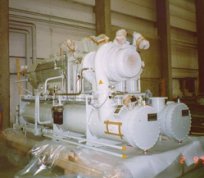 |
Figure 193: Undismantled large machine; sensitive parts enclosed in plastic film |
| Figure 194: Undismantled large machine; sensitive parts enclosed in plastic film |
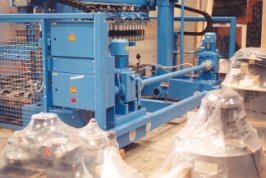 |
Bolting machinery to case bottom, sealed package (see Fig. 195).
Machinery which is to be shipped in containers must always be provided with packaging which is fit for purpose. This particularly applies if the machinery is not being transported in a door-to-door container. An exception can be made if the machinery is being transported in a door-to-door container (FCL). In order to minimize cargo securing requirements within the container, it is advisable to tailor to the case bottom to the internal dimensions of the container (modularization), so making it possible to achieve a tight fit stow. Any cargoes which are at risk of tipping must always be additionally secured. Nailing cargo down to the container floor is not an acceptable cargo securing method.
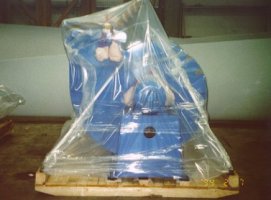 |
| Figure 195: Sealed package with machinery enclosed in water vapor-impermeable plastic film and bolted to the pallet in such a way that the film is not damaged. |
Machinery which is sensitive to impact may be protected with shock absorbing materials, such as plastic foams (polystyrene (PS), polyurethane (PU) or polyethylene (PE). Control units, special tools, assembly aids, auxiliary substances, lubricants etc. are often provided with their own packaging and enclosed in the machinery case.
Machinery with a relatively low package weight can be transported in paperboard cartons, inside which the machinery is wrapped in oiled or VCI paper or in open-end bags, or cradled in molded polystyrene inserts, corrugated board or the like. High strength corrugated board is used in order to provide good puncture resistance.
The packages must also be properly marked in accordance with standard 4711 (see TIS). Slips of paper, placards and the like should not be used as they can easily be torn off.
Corrosion
Corrosion begins at a relative humidity of 40% and rapidly accelerates at relative humidities of > 60% (see Fig. 196). Depending upon the sensitivity of the goods to corrosion, even the slightest rust film may result in total loss of the goods. Protection must accordingly be provided from all forms of moisture (seawater, rain, condensation water and excessive humidity). The most effective corrosion protection method, which can prevent corrosion, is to use desiccants in a package which is impermeable to water vapor. Where "liquid" corrosion protection agents are used (coating method), care must be taken to ensure for transport operations in the tropics that they have a high dropping point of > 80°C. If the dropping point is low, there is a risk that the corrosion protection agent, which is of a solid consistency in temperate latitudes, will drip or run off the surfaces to be protected and will thus be unable to perform its protective task.
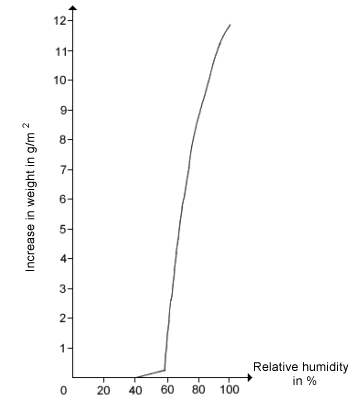 |
Figure 196: Ferrous corrosion as a function of relative humidity; 0.01% SO2 content; duration of test, 55 days. |
Another corrosion protection option is the VCI method. Volatile corrosion inhibitors are chemicals which are introduced into the packaging on a substrate, for example paper. The substances evaporate continuously and are deposited on the surface of the goods, where they displace the oxygen and so provide corrosion protection. Unlike with the desiccant method, packaging does not need to be hermetically sealed. It is generally sufficient to wrap the goods in film. The various VCI agents do not provide equally good protection for all metal alloys. They must be tailored to the particular product in order to be able to guarantee perfect corrosion protection. If many different metals and alloys have been used in a piece of equipment, the desiccant method is the most reliable corrosion protection method.
The American Rust Standard is very frequently used in international trade to describe the degree of rusting.
The degree of rusting of steel consignments should be recorded in the shipping documents before the container is packed, possibly using the following definitions:
- Wet before shipment
- Partly rust stained to rusty
- Gear marked
- Contaminated by foreign substance
- Contaminated by saltwater
- Chafed in places
- Packing torn exposing contents
Temperature
If the temperature falls below freezing, frost damage may occur, e.g. due to ice expansion rupture at points where condensation, water drips and drainage water have collected. Lubricating or insulating oils assume an ointment-like consistency and it is thus best to use oils with a high solidification point or multigrade oils. Rubber conveyor belts or cable insulation may become brittle and break.
Insect infestation
Insect infestation need not generally be expected; however, damage may be caused to the packaging by creatures which mistakenly find their way in, such as beetles and beetle larvae. In their search for new breeding grounds, pests can destroy the packaging.
The common packaging materials paper and paperboard (corrugated board is the most susceptible) and most plastic films do not offer full protection against insect infestation. Creased packaging materials exhibit lower resistance than smooth materials because insects preferentially attack folded materials.
Before packing, the container must be examined for the absence of pests. Insect-resistant packaging is preferred. When wooden packaging materials or cargo securing materials are used, it may, under certain circumstances, be necessary to comply with the quarantine regulations of the country of destination and a copy of the wood treatment certificate may have to be placed in a highly visible location on the container. In the case of container transport to Australia and New Zealand, proof of adequate treatment against the sirex wasp must be provided.
In some cases, problems with rodents may arise during storage of the machinery before or after shipment. In particular, if such animals are unintentionally locked into the container on completion of packing, they can cause considerable damage to wiring, pipework etc., which may result in malfunctioning.